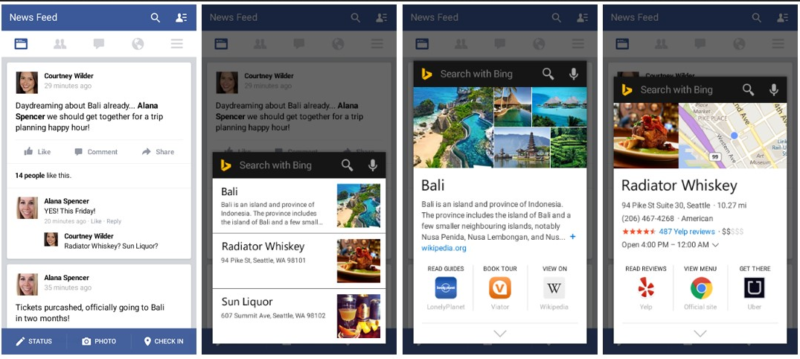Bing Lures App Developers With New Knowledge Graph API
Bing has announced a new Knowledge and Actions Graph API for Android developers. The objective is to get Android developers to deeply integrate Bing Knowledge Graph information — “21 billion associated facts, 18 billion links to key actions and over 5 billion relationships between entities” — into their apps to enabled an enhanced experience and […]
Bing has announced a new Knowledge and Actions Graph API for Android developers. The objective is to get Android developers to deeply integrate Bing Knowledge Graph information — “21 billion associated facts, 18 billion links to key actions and over 5 billion relationships between entities” — into their apps to enabled an enhanced experience and improve app engagement and retention.
Here’s Bing’s pitch to developers:
Developers can innovate using this enormous asset to fulfill their users’ information needs and help users perform searches in context, instead of forcing users to leave their apps to perform searches. For instance, a messaging app could add a Bing snapshot with actionable info on a restaurant, making it easier for a group to plan an evening. A social media app could augment users’ photos with information about the locations of each photo. A news app could show definitions and descriptions of terms that users want to drill into. A music app could augment content with snapshots of artists and songs. Where Bing has rights to share the data, we want to empower the developer community to create rich, innovative experiences that delight.
Bing is soliciting developer participation now but the API won’t be formally available until the fall. However Bing is showcasing some of these enhanced in-app capabilities today with a consumer experience called “Bing Snapshots.” I wrote about that in a separate article on Search Engine Land.
Although the company may not appreciate the comparison, Bing Snapshots is similar to “Google Now on Tap.” It allows for the presentation of search content and other actions without leaving an app. To access that experience consumers need to update or install the Bing app. Then they simply “long-press” the Android home button while in a third party app to generate a Bing overlay that offers enhanced information and relevant actions.
Bing “reads the contents” of the user’s screen and presents additional content and information. As the screens above show, users having a discussion in Facebook about travel plans or restaurants would see additional information about those places. In some cases they could also take action directly from within the overlay — e.g., make a reservation or book a tour.
Bing told us on a briefing yesterday that importing the Knowledge Graph into apps is part of the broader evolution of search. While there will always be “destination search,” this takes search (and related capabilities) directly to users in apps. From a developer point of view, it’s not clear at this point how the Bing API integration will be presented. Snapshots has heavy Bing branding.
With its new API, which the company points out is unmatched by Google, Bing is finding ways to offer developers useful content and search capabilities in exchange for exposing Bing to Android owners who probably otherwise wouldn’t use it.
Opinions expressed in this article are those of the guest author and not necessarily MarTech. Staff authors are listed here.
Related stories

